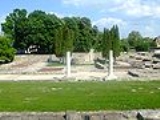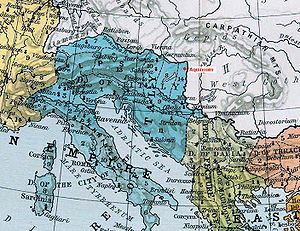
Aquincum
Encyclopedia

Pannonia
Pannonia was an ancient province of the Roman Empire bounded north and east by the Danube, coterminous westward with Noricum and upper Italy, and southward with Dalmatia and upper Moesia....
province within the Roman Empire
Roman Empire
The Roman Empire was the post-Republican period of the ancient Roman civilization, characterised by an autocratic form of government and large territorial holdings in Europe and around the Mediterranean....
. The ruins of the city can be found today in Budapest
Budapest
Budapest is the capital of Hungary. As the largest city of Hungary, it is the country's principal political, cultural, commercial, industrial, and transportation centre. In 2011, Budapest had 1,733,685 inhabitants, down from its 1989 peak of 2,113,645 due to suburbanization. The Budapest Commuter...
, the capital city of Hungary
Hungary
Hungary , officially the Republic of Hungary , is a landlocked country in Central Europe. It is situated in the Carpathian Basin and is bordered by Slovakia to the north, Ukraine and Romania to the east, Serbia and Croatia to the south, Slovenia to the southwest and Austria to the west. The...
. It is believed that Marcus Aurelius may have written at least part of his book Meditations
Meditations
Meditations is a series of personal writings by Marcus Aurelius, Roman Emperor 161–180 CE, setting forth his ideas on Stoic philosophy....
at Aquincum.
Originally settled by the Eravisci
Eravisci
The Eravisci, a Celtic people, were the original inhabitants of Dunaújváros. The centre of the tribe may be assumed to have been on Gellért Hill in the Budapest of today....
, a Celtic tribe, Aquincum served as a military base (castrum), having been part of the Roman border protection system called "limes
Limes
A limes was a border defense or delimiting system of Ancient Rome. It marked the boundaries of the Roman Empire.The Latin noun limes had a number of different meanings: a path or balk delimiting fields, a boundary line or marker, any road or path, any channel, such as a stream channel, or any...
". Around AD 41-54, a 500-strong cavalry unit arrived, and a Roman legion
Roman legion
A Roman legion normally indicates the basic ancient Roman army unit recruited specifically from Roman citizens. The organization of legions varied greatly over time but they were typically composed of perhaps 5,000 soldiers, divided into maniples and later into "cohorts"...
of 6000 men was stationed here by AD 89. The city gradually grew around the fortress, and after Pannonia was reorganised by the Romans in AD 106, Aquincum became the capital city of Pannonia Inferior. The city had around 30,000 to 40,000 inhabitants by the end of the 2nd century, and covered a significant part of the area today known as the Óbuda
Óbuda
Óbuda was a historical city in Hungary. United with Buda and Pest in 1873 it now forms part of District III-Óbuda-Békásmegyer of Budapest. The name means Old Buda in Hungarian...
district within Budapest. Ruins from the old Roman settlement can be seen in other parts of Budapest as well, notably Contra-Aquincum and the Amphitheater.
People living in the settlement could enjoy the achievements of the Empire, like central heating in the houses, public baths
Thermae
In ancient Rome, thermae and balnea were facilities for bathing...
, a Mithraeum
Aquincum Mithraeum (of Victorinus)
The Aquincum Mithraeum is a temple to the Roman god Mithras near Budapest in Hungary. The temple was built within a townhouse in the Roman city of Aquincum, on the outskirts of the modern city of Budapest, Hungary....
and palaces, as well as amphitheatre
Amphitheatre
An amphitheatre is an open-air venue used for entertainment and performances.There are two similar, but distinct, types of structure for which the word "amphitheatre" is used: Ancient Roman amphitheatres were large central performance spaces surrounded by ascending seating, and were commonly used...
s for gladiatorial combats and beast fights.
Many historic artifacts from the city now appear in the Aquincum Museum
Aquincum Museum
The Aquincum Museum is a museum in Budapest, Hungary, Szentendrei út 135. Archeological findings from the remains of Aquincum are on display there. These include items from the local Mithraeum. It has an indoor and outdoor part.-External links:*...
.

